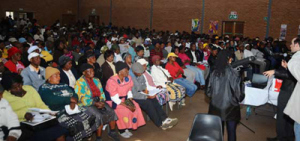Al Jazeera – Risky Business
 Fifty years from now, one in three people worldwide will live in slums like Tondo in the sprawling mega city of Manila – built without proper sanitation, lacking medical facilities, and packed to capacity.
Fifty years from now, one in three people worldwide will live in slums like Tondo in the sprawling mega city of Manila – built without proper sanitation, lacking medical facilities, and packed to capacity.
But in the face of all life’s hardships, finding work and making a living – no matter how – is the only way for most residents to ensure their survival.
Ricky Fuertes makes his living sorting through rubbish – tonnes of it, every day. He earns $2.50 a day scavenging so he can feed his family of five. But he faces his biggest challenge when his slum his burnt to the ground.
Nearby, Chito Barquin dives for his money. He normally makes a living working salvage jobs, but times are tough so he now dives in polluted waters for old tyres he can sell. His meager catch must feed his wife and five children.
None of Chito’s three grown-up children graduated from high school and the family has all its hopes pinned on their youngest, 15-year old Evelyn. But Chito are struggling to afford to keep her in school.
Meanwhile, tyre repair man Freddie Awayang runs his business on one of the busiest road in the slum. He has been repairing rubber for 32 years but local competition is affecting his profits.
And now he has even bigger things to worry about: He has been served with an eviction notice, and his baby granddaughter is in need of a life-changing operation.
Go to: http://www.aljazeera.com/programmes/the-slum
J. Brooks Spector – Johannesburg’s New Towns: The Utopian Answer To The City’s Needs Or Another Problem To Fix?
 dailymaverick.co.za. September 2014. For as long as people have been living in towns and cities, somebody has planned the urban space – perhaps just the way Kublai Khan did it for Xanadu. Build it here; don’t build there. Add a palace, a temple, walls, streets and bridges, homes for the rich, hovels for the poor, water, and – more recently – electricity, IT connectivity and Mag-Lev trains.
dailymaverick.co.za. September 2014. For as long as people have been living in towns and cities, somebody has planned the urban space – perhaps just the way Kublai Khan did it for Xanadu. Build it here; don’t build there. Add a palace, a temple, walls, streets and bridges, homes for the rich, hovels for the poor, water, and – more recently – electricity, IT connectivity and Mag-Lev trains.
Recently, this writer came across a beautifully drawn 16th-century plan of the city of Milan. The way the city was depicted, Milan had a magnificent, balanced symmetry. Its walls were precisely designed to be works of architectural beauty as well as to offer enfilade fire on any would-be attackers. And there was a sumptuous ducal palace located in the northern quadrant of the city, balanced between East and West.
Read more: http://www.dailymaverick.co.za/johannesburgs-new-towns-the-utopian-answer
Het Ubuntuplein in Zutphen – Een buurt waar ouderen wonen, werken en voor elkaar zorgen
 Nieuwe solidariteit in de derde levensfase. September 2014. In ZorgLab2015 komen pioniers aan het woord die vanuit hun betrokkenheid zoeken naar nieuwe vormen van zorg en samenleven. Hugo Versteeg pleit al ruim tien jaar voor een andere invulling van de zogeheten derde levensfase; de generatie van zestig plussers met een carrière achter zich die een ander evenwicht willen tussen het werk en de invulling van hun vrije tijd. Als bestuurslid van de coöperatie Ubuntuplein zet hij zich in voor de bouw van een buurt waar ze samen wonen, werken en zorg delen. De plannen daarvoor zijn in een ver gevorderd stadium. In dit artikel een blik achter de schermen als aanloop naar een serie waarin wij de totstandkoming ervan op de voet volgen.
Nieuwe solidariteit in de derde levensfase. September 2014. In ZorgLab2015 komen pioniers aan het woord die vanuit hun betrokkenheid zoeken naar nieuwe vormen van zorg en samenleven. Hugo Versteeg pleit al ruim tien jaar voor een andere invulling van de zogeheten derde levensfase; de generatie van zestig plussers met een carrière achter zich die een ander evenwicht willen tussen het werk en de invulling van hun vrije tijd. Als bestuurslid van de coöperatie Ubuntuplein zet hij zich in voor de bouw van een buurt waar ze samen wonen, werken en zorg delen. De plannen daarvoor zijn in een ver gevorderd stadium. In dit artikel een blik achter de schermen als aanloop naar een serie waarin wij de totstandkoming ervan op de voet volgen.
Op een voormalig industrieterrein aan de noordzijde van het NS-spoor, heeft de gemeente Zutphen de bouw van een gloednieuwe woonwijk gepland: Noorderhaven. Het bouwverkeer rijdt er af en aan, links en rechts lege kavels met wervende informatieborden. De eerste appartementen zijn inmiddels bewoond, ze kijken uit op een braak terrein waar een kleine haven gepland is. De oude pakhuizen en fabrieksloodsen in de steigers even verderop bieden binnenkort onderdak aan innovatieve ondernemers. Schuin daar tegenover een flat, op de balkons staan opgestapelde verhuisdozen, kratten bier en tijdelijk gestald huisraad van bewoners die er kortgeleden zijn ingetrokken. De eerste contouren van de nieuwe wijk zijn zichtbaar. Wie het treinstation van Zutphen via de achteruitgang verlaat, ziet recht voor zich op ruim honderd meter afstand een rij felgele containers. Ze staan op een kaal terrein, omringd door een ijzeren hekwerk. Deze afrastering markeert het grondgebied waar binnenkort de eerste paal geslagen wordt voor het Ubuntuplein.
Geen exclusief domein
Doel van het Ubuntuplein-project is het creëren van een buurt waar oudere generaties zich als een vis in het water kunnen voelen. Geen gated community of resort voor pensionado’s, maar een plek voor bewoners die er voor kiezen om midden in de samenleving te staan. En van plan zijn om ook op hoge leeftijd een actief en sociaal leven te leiden. De kiem voor dit plan dateert van ruim tien jaar geleden. In 2004 zocht een groep senioren elkaar vond in hun visie op kwesties als sociale duurzaamheid en zinvol ouder worden. Hugo Versteeg was één van hen. Deze sociale pioniers spraken af hun ideeën uit te werken en ook samen in praktijk te brengen. ‘Kijk, dit is het resultaat,’ wijst Hugo Versteeg naar een folder met een artist impression van de buurt die het moet worden, inclusief plattegronden, technische gegevens en indicaties van prijzen voor het huren en kopen van de beschikbare ruimtes. Het gepresenteerde plan behelst ruim tweehonderd levensloopbestendige woonruimtes en circa 20 kleinere ruimtes die te gebruiken zijn als atelier, werkpraktijk, kantoor of hobbyruimte. En eventueel als gastverblijf voor logés. Er zijn woningen in de sociale- en in de vrije sector, het is een mix van huur, koop- en zorgappartementen. Een heel gevarieerd aanbod, bestemd voor ouderen, ondernemers, jonge gezinnen en mensen die professionele zorg nodig hebben. Er is een grand café gepland, er zijn plekken vrijgehouden voor commerciële ruimtes en een ruim aantal plaatsen wordt gereserveerd waar de alleroudsten terecht kunnen voor verblijf- en verpleegzorg. Dit laatste onderdeel gebeurt in samenwerking met de zorgorganisatie Sutfene. Er wordt nog gekeken naar de mogelijkheid van kinderopvang en eventueel andere voorzieningen voor de jongere generaties. Want in plaats van een exclusief domein voor ouderen, is het experiment in Zutphen juist bedoeld om de buurt zo in te richten dat generaties, jong en oud, wel met elkaar in contact komen. En mogelijk iets voor elkaar kunnen betekenen.
Penwell Dlamini – More Homes For Rent Planned For Informal Settlements
 timeslive.co.za. September 2014. In the past few months there have been violent demonstrations in Ekurhuleni by people demanding housing. The metro has 119 “informal settlements”.
timeslive.co.za. September 2014. In the past few months there have been violent demonstrations in Ekurhuleni by people demanding housing. The metro has 119 “informal settlements”.
The member of the Ekurhuleni mayoral committee responsible for settlements, Queen Duba, said the metro was changing the way it was dealing with demand for housing.
“We must cater for people with their different needs. You cannot assume that, just because a person is in an informal settlement, he wants an RDP house.
“You might find that the person in the informal settlement has money to build a house and the only thing they need is access to land,” Duba said.
There were currently 52 housing projects in the pipeline at different phases of development in Ekurhuleni, she said.
Read more: http://www.timeslive.co.za/informal-settlements
Tariq Toffa – The ‘African City Of The Future’ : Johannesburg’s 2040 Vision
futurecapetown.com. September 2014. Launched in 2011, the Johannesburg 2040 Growth and Development Strategy (Joburg 2040 GDS) defines Johannesburg’s vision for the next 30 years, toward a vibrant, equitable, diverse, “World Class African City of the Future.” It consolidates various other City strategies, and included a wide-reaching engagement and feedback process (GDS outreach).
Joburg 2040 responds to two contexts: continued transformation of the inherited Apartheid City, and the uncertainties of present and future challenges such as migration, globalisation, climate change, natural resource scarcity, and financial markets. Understanding these and other challenges of modern cites as resulting from complex and inter-related factors, key to the Joburg 2040 strategy is its cross-cutting nature, moving away from a narrow sectoral approach toward a more thematic approach to which all targeted City interventions can aim. To this end, three concepts were devised: resilience (the capacity to change and adapt), sustainability (development that does not destroy natural ecology) and livability (quality of life). The City has similarly also defined four inter-related drivers to achieve this: social, environmental, economic and institutional/political change.
Read more: http://futurecapetown.com/johannesburgs-2040-vision
Jan Briffaerts – When Congo Wants To Go To School. Educational Realities In A Colonial Context
Rozenberg Quarterly will publish on paper and online:
Jan Briffaerts – When Congo wants to go to school. Educational realities in a colonial context. An investigation into educational practices in primary education in the Belgian Congo (1925-1960) – Pb – 420 pag. – € 39,50 – ISBN 978 90 3610 144 8 – 2014
The education system in the Congo was widely considered to be one of the best in colonial Africa, in particular because of its broad reach among the Congolese youth. At independence however, the wake-up call was brutal as soon it became clear that the colonial educational system had neglected to form an educated class of people able to cope with administrating one of Africa’s biggest and economically most important countries. To be able to understand the mechanisms and effects of missionary education it is most enlightening to go back to the classroom and investigate the everyday reality of school. What did missionary education do exactly, how did it work, what did it teach, and how did it relate to its subjects, the children of the Congo?
This study gives clear insights into the everyday realities of colonial education. It is the result of historical research into educational practices and realities in catholic missionary schools in the Tshuapa region, located in the south of the Congolese province of Equateur. It is based on a rich array of historical source material, ranging from missionary archives and mission periodicals through to contemporary literature and interviews with missionnaries and former pupils who experienced colonial education themselves. The title, “When Congo wants to go to school… ” refers to one of many articles published in Belgian mission periodicals on the subject of the education and civilisation work carried out by missionaries in the Belgian colony.
The complete book now online:
Introduction & A Few Preliminary Remarks
Educational Organisation In The Belgian Congo (1908-1958)
The Missionaries And The Belgian Congo: Preparation, Ideas And Conceptions Of The Missionaries
Catholic Missions In The Tshuapa Region
Part II – Realities
The Educational Climate
Educational Comfort
The Subject Matter
Educational Practices
Part III – Acti Cesa
The Short Term: Reactions
The Long Term: Memories
As Justification And Conclusion
Appendices & Bibliography




